Fuel prices in South Africa are rising, but you can save up to 20% on fuel costs by changing your driving habits and maintaining your vehicle. Here’s how:
- Stick to Speed Limits: Driving at 110 km/h instead of 120 km/h can save 15% on fuel.
- Accelerate Smoothly: Avoid aggressive acceleration to reduce fuel usage by 15-20%.
- Check Tyre Pressure Weekly: Properly inflated tyres improve efficiency by 3-5%.
- Remove Roof Racks: Unused racks can increase fuel consumption by up to 25%.
- Combine Trips: Group errands to avoid multiple cold starts and save 15-20%.
- Use AC Strategically: Use air conditioning only when necessary to avoid a 20% increase in fuel use.
- Coast to Slow Down: Use natural momentum to save 5-8% on fuel in city driving.
- Service Your Car Regularly: Routine maintenance can improve fuel economy by up to 20%.
- Track Driving Habits: Use apps or tools to monitor and adjust your driving behavior.
- Remove Extra Weight: Clear unnecessary items from your car to improve efficiency by 1-2%.
Quick Comparison of Savings
| Strategy | Potential Savings (%) | Monthly Cost Impact* |
|---|---|---|
| Speed Management | 10-20% | R500-R1,000 |
| Smooth Acceleration | 15-20% | R750-R1,200 |
| Tyre Pressure Maintenance | 3-5% | R150-R250 |
| Roof Rack Removal | Up to 25% | R750-R900 |
| Trip Consolidation | 15-20% | R500-R1,000 |
| AC Usage Management | Up to 20% | R450-R900 |
| Coasting | 5-8% | R250-R500 |
| Regular Servicing | Up to 20% | R1,000-R2,000 |
| Driving Habit Tracking | 12-15% | R600-R900 |
| Weight Reduction | 1-2% | R50-R100 |
*Based on 1,500km/month at R22/L petrol.
Start saving today by applying these practical tips to your daily driving routine!
How to save money on fuel in any car – 10 fuel saving tips that actually work
1. Keep to Speed Limits
Driving at 110 km/h instead of 120 km/h on highways can cut fuel consumption by up to 15% [3]. At Highveld altitudes (1,300-1,800m), thinner air causes engines to use 12-15% more fuel [6]. For Gauteng commuters, who deal with both traffic and high altitudes, managing speed becomes even more important.
Fuel efficiency depends on the type of road:
| Road Type | Optimal Speed | Potential Savings |
|---|---|---|
| Highways | 100-110 km/h | 15-20% less fuel than at 120 km/h |
| Rural roads | 80-90 km/h | 8-12% reduction |
| Urban areas | 50-60 km/h | Most efficient range |
Here’s an example: Cape Town drivers commuting 40km daily saved an average of R287 per month by lowering their speed from 120 km/h to 110 km/h, based on 2024 fuel prices [3][9].
To get the most out of your fuel while staying within legal limits:
- Use cruise control on highways to save 7-14% on fuel [7].
- Build momentum before tackling hills for better efficiency [3].
"A February 2024 N1 highway study showed drivers maintaining 100 km/h used 7.2L/100km versus 8.6L at fluctuating speeds – a 19.4% increase", says AA Technical Manager John van Niekerk.
Take advantage of built-in eco-modes in your car and use GPS apps like Waze to help maintain steady, fuel-efficient speeds [1][6].
2. Accelerate smoothly
Quick, aggressive acceleration is a major culprit when it comes to wasting fuel on South African roads. Research from SANEDI shows that simply using better acceleration techniques can cut fuel consumption by 15-20% in urban driving conditions [3]. This works hand-in-hand with sticking to speed limits (Section 1) for better efficiency.
| Driving Condition | Potential Fuel Waste | Recommended Approach |
|---|---|---|
| Cape Town hills | 15-30% extra consumption | Build momentum before inclines |
| Stop-start traffic | 10-40% increased usage | Anticipate stops, accelerate gradually |
If you’re driving a manual car, aim to shift gears before hitting 2,500 RPM to keep fuel use in check [3][9]. For automatic cars, use the "eco mode" if available and apply light, steady pressure to the accelerator for smoother gear shifts.
"Our 2022 study of 100 Johannesburg drivers showed an 18% average fuel saving over 3 months simply by adopting smoother acceleration habits", says Dr. Thabo Molekoa from SANEDI.
Tools that can help you accelerate more efficiently include:
- Instant fuel consumption displays to monitor real-time efficiency
- RPM gauges to maintain optimal engine speeds
- Gear shift indicators for timing gear changes [6][10]
Cartrack‘s telematics data highlights that racing off from traffic lights wastes a lot of fuel in South African cities. Instead, ease off the accelerator early when approaching traffic lights or stops. Coasting, rather than braking hard and accelerating again, helps maintain momentum. We’ll dive deeper into coasting strategies in Section 7 [3][9].
3. Check tyre pressure weekly
Keeping your tyres at the correct pressure is one of the easiest and most cost-effective ways to save on fuel in South Africa. Research from DEKRA shows that properly inflated tyres can improve fuel efficiency by 3-5% compared to underinflated ones [9]. When combined with managing your speed (Section 1) and smooth acceleration (Section 2), this simple habit can lead to noticeable savings.
Running on underinflated tyres can cost you more than you think. For every 10 PSI below the recommended level, your vehicle can use up to 10% more fuel due to increased rolling resistance [2][3]. This added resistance puts extra strain on the engine, especially during long-distance travel.
| Condition | Fuel Impact | Cost Impact |
|---|---|---|
| 8 PSI Under | +4% city consumption | R1.50/km extra |
| 10 PSI Under | +10% fuel usage | R3.00/km extra |
| Properly Inflated | Optimal efficiency | Baseline costs |
To get accurate readings, check your tyre pressure weekly when the tyres are cold. Use a digital gauge and follow the pressure recommendations listed on your vehicle’s door jamb.
South Africa’s climate adds another layer of complexity. Tyres lose 1 PSI for every 6°C drop in temperature, making regular checks especially important for drivers traveling between coastal areas and the Highveld. The altitude and temperature changes in these regions can significantly affect tyre pressure.
"Our 2024 fleet data shows that vehicles with properly maintained tyre pressure consistently achieve 8-12% better fuel economy compared to those with irregular maintenance patterns", says Bidvest’s Technical Director [7].
For bakkie and SUV drivers, there’s an extra tip: increase your tyre pressure by 4-6 PSI when carrying heavy loads [4][7]. This adjustment helps maintain fuel efficiency while managing the added weight.
Most petrol stations are equipped with calibrated air pumps, making it convenient to check and adjust your tyres during routine fuel stops. Plus, maintaining tyre pressure ties in nicely with weight reduction strategies discussed in Section 10.
4. Remove unused roof racks
Taking off unused roof racks is a simple yet effective way to cut fuel costs, especially for long-distance driving in South Africa. Studies reveal that empty roof racks can boost fuel consumption by as much as 25% at highway speeds [1].
Here’s how different rack types affect fuel use:
| Rack Type | Highway Speed Impact | Monthly Cost* |
|---|---|---|
| Box-style Carrier | 12-15% more fuel | R750-R900 |
| Permanent Metal Rack | 8-12% more fuel | R500-R800 |
| Temporary Soft Carrier | 5-8% more fuel | R300-R500 |
| *Based on 1,500km/month at current SA prices [3][6] |
Empty racks create drag, forcing your vehicle to use more fuel – this is especially noticeable on highways like the N1 and N3. Reducing drag ties into overall vehicle upkeep, which is discussed further in Section 8.
Quick tip: Use racks with quick-release systems so you can easily remove them when they’re not in use [4][5].
If you need roof storage but still want to save fuel, try these strategies:
- Add a front deflector to reduce drag by up to 18% [6].
- Opt for streamlined crossbars instead of traditional square ones.
- Consider rear-mounted racks, which are often more fuel-efficient [2].
Interestingly, removing a 20kg roof rack can improve fuel efficiency more than taking 100kg out of your trunk [3][9].
"CSIR tests show modern vehicles lose significant efficiency with roof accessories. Even small additions like bike racks can increase consumption by 0.25L/100km – costly with current fuel prices", notes the CSIR Transportation Technology Centre [8].
When putting roof racks back on, always check the manufacturer’s torque specifications (usually 25-35Nm) to ensure safe installation [4][5].
5. Combine multiple trips
Strategic trip planning can significantly lower fuel costs, beyond simple vehicle adjustments like removing roof racks (see Section 4). According to AA South Africa, combining trips instead of making separate short ones can reduce your monthly fuel expenses by 15-20% [3][5]. This is especially important because cold engine starts consume 20% more fuel during the first few kilometers [5].
How Trip Types Affect Fuel Usage
| Trip Type | Fuel Efficiency | Estimated Cost Impact |
|---|---|---|
| Single Long Trip | Most efficient | R450-600 |
| Two Medium Trips | Moderately efficient | R300-400 |
| Multiple Short Trips | Least efficient | R0-150 |
Using Technology to Optimize Routes
Modern navigation apps make it easier to combine trips efficiently. Use these tools to locate nearby service points and avoid areas with heavy traffic. This not only saves time but also reduces fuel consumption.
Adapting to Load-Shedding
In South Africa, planning trips around load-shedding schedules is essential. Combined trips can help you avoid:
- Increased fuel use from night driving with headlights
- Wasted fuel while idling at non-functioning traffic lights
- Extra trips during peak traffic hours
Real-World Impact
"Each consolidated trip reduces emissions by 0.3kg per 5km saved. For a typical Capetonian making 3 weekly combined trips, this equals 46kg annual emission reduction", says the Automobile Association [3][6].
Tips for Effective Trip Planning
- Start with the farthest destination and work your way back.
- Group errands by location to minimize driving distance.
- Align your trips with load-shedding schedules to avoid delays.
Important Note: Avoid unnecessary detours. Even a 2km detour can cancel out 40% of the fuel savings you’d gain from combining trips [3][5].
This approach pairs well with the energy-saving climate control strategies discussed next in Section 6.
6. Use Air Conditioning Strategically
Managing your car’s air conditioning wisely can make a noticeable difference in fuel consumption, especially in South Africa’s warm climate. Studies show that using air conditioning can increase fuel use by up to 20% [3][9]. To get the most out of your fuel, it’s important to use AC thoughtfully.
Cooling Methods Based on Speed
The impact of air conditioning on fuel efficiency varies depending on your speed:
| Speed Range | Best Cooling Option | Fuel Impact |
|---|---|---|
| Below 60 km/h | Open windows | 8-10% higher consumption |
| 60-80 km/h | Depends on conditions | Varies |
| Above 80 km/h | Use air conditioning | Around 10% consumption increase |
Tips for Keeping the Cabin Comfortable
To use your air conditioning effectively, adjust your approach based on the situation. Research from DEKRA suggests that AC is most useful when temperatures hit 28°C or higher, or when humidity exceeds 60% [9]. Keep these tips in mind:
- Ventilate the car to let out hot air before turning on the AC.
- Once the cabin is cool, switch to recirculation mode.
- Set the temperature to around 22-23°C for better efficiency.
Keep Your AC in Good Shape
Regular maintenance is key to keeping your air conditioning efficient. For example:
- Cleaning condenser coils can improve heat dissipation by up to 30% [4].
- Ensuring refrigerant levels are correct prevents efficiency losses of 15-20% [5].
It’s recommended to service your AC every 15,000 km. This ties into general vehicle upkeep, which is covered in Section 8.
"Cartrack data shows alternating 10-minute AC use with ventilation saves 18% fuel", according to a report from the AA [6].
Smarter Cooling Habits
To save fuel, avoid using AC during:
- Steep uphill drives
- Heavy traffic
- When the engine is still cold
Pro Tip: Parking in shaded spots can lower your car’s interior temperature by up to 15°C [9]. This reduces the workload on your AC when you start driving, helping you save fuel right from the get-go.
sbb-itb-09752ea
7. Coast to Slow Down
Coasting is a simple yet effective way to cut down on fuel usage, especially on South African roads. When done correctly, it can save you around 5-8% on fuel during city driving [9]. Pair this with smooth acceleration (see Section 2) and smart route planning (see Section 5) for even better results.
Where to Coast
South Africa’s varied terrain provides plenty of chances to use coasting to your advantage. Here are some general guidelines:
| Scenario | Ideal Speed Range |
|---|---|
| Going downhill | 60-80 km/h |
| Approaching traffic | 40-60 km/h |
| Rolling hills | 70-90 km/h |
How to Coast Safely
Start by planning ahead. Anticipate when you’ll need to slow down and let your car coast naturally while staying in gear. Aim for speeds 5-10 km/h above the target zone [3]. Look ahead for changes in traffic or terrain.
Modern engines are designed to minimize fuel use when coasting in gear. To ensure safety, keep your brakes and transmission in good condition (see Section 8).
"Cartrack’s telematics show 12-15% fuel reduction in fleets using progressive deceleration techniques when approaching stops", according to fleet management data [6].
Mistakes to Watch Out For
- Avoid coasting in neutral or disengaging the clutch on inclines. This can actually increase fuel consumption and reduce control [5].
- Always use your brake lights early when slowing down significantly to keep other drivers informed [9].
Tips for Smarter Coasting
Combine coasting with steady speed management (see Section 1). On uphill stretches, let your car gain speed at the base of the hill, using that momentum to climb rather than accelerating halfway up. This approach helps you save fuel and maintain smooth driving.
8. Service your car regularly
Driving on South Africa’s dusty roads and dealing with potholes means your car needs regular upkeep to stay fuel-efficient. Keeping your vehicle in good condition can improve fuel economy by up to 20%. Combine this with proper tyre pressure (see Section 3) and streamlined aerodynamics (see Section 4) for even greater savings.
Recommended Service Intervals
| Maintenance Task | Recommended Interval | Fuel Savings Potential |
|---|---|---|
| Oil Change | 10,000-15,000 km | 1-2% |
| Air Filter | 20,000-40,000 km | 10-15% |
| Spark Plugs | 60,000 km | 2-4% |
| Wheel Alignment | Every 6 months | 2-3% |
These intervals are a good starting point, but South Africa’s dusty conditions mean you might need to service your car more often. Many local experts suggest servicing every 10,000 km instead of the standard 15,000 km [3][5].
Focus Areas for South African Roads
In South Africa, a clean air filter is especially critical. Dusty environments can clog filters quickly, causing your car to burn more fuel. According to the AA, a clogged air filter can increase fuel use by as much as 15% in just six months [3].
Using the wrong oil is another common issue – 38% of drivers in South Africa use incorrect oil grades, which hurts fuel efficiency [4]. Always stick to the oil grade recommended by your car’s manufacturer. This simple step can cut engine friction and improve fuel economy by 1-2% [4].
"Our fleet management data shows that vehicles following strict maintenance schedules consume an average of 0.8 liters less fuel per 100 km driven", says Johan van Vreden, AA Technical Manager, referring to their 2022 study of 1,000 vehicles [3].
Maintenance Support
Many affiliated service providers offer:
- Free tyre pressure checks at fuel stations
- Certified technicians for basic services
- High-quality replacement parts with warranties
Signs Your Car Needs Attention
Watch out for these warning signs that could hurt your fuel efficiency:
- Engine warning lights (over half of drivers ignore these!) [6]
- Strange engine noises
- Rough idling or stalling
Regular maintenance isn’t just about saving fuel – it keeps your car running smoothly and prevents bigger problems down the line.
9. Track Your Driving Habits
Thanks to modern tools, keeping an eye on your driving habits has never been simpler. This goes hand-in-hand with regular servicing (see Section 8) by pinpointing behaviors that might be costing you extra fuel. For South African drivers, tweaking these habits can lead to noticeable fuel savings.
What to Watch for
| Behavior | Impact on Fuel Usage | Target Range |
|---|---|---|
| Heavy Acceleration | Increases usage by +15% | Accelerate gently |
| High Engine Revolutions | Fuel drain above 3,000 RPM | Stay below 2,200 in city driving |
| Idling Too Long | Uses 1-2% of tank/hour | Limit idling to under 30 seconds |
Budget-Friendly Tracking Tools
There are plenty of affordable ways for South African drivers to monitor their driving habits. The AA’s Fuel Saver app (free) uses color-coded scores to rate your efficiency, while Engen‘s Driver Feedback System offers free driving analyses when you fill up [4][7].
For more detailed tracking, Cartrack’s telematics system costs R299/month. It provides real-time data on acceleration, speed consistency, and fuel consumption [6].
How Drivers Are Saving
In Durban, drivers using basic tracking apps have reported cutting fuel use by 12-15% simply by reviewing their habits weekly [4][5]. These tools build on strategies like smooth acceleration (see Section 2) and smarter route planning (see Section 5).
Quick Tips for Saving Fuel
- Avoid sudden braking: Anticipating stops can save you 8-12% on fuel [3][5].
- Check idling time weekly: Apps often show how much money you’ve wasted on unnecessary idling, like "You wasted R47 in fuel through excessive idling" [5].
10. Remove Extra Weight
Carrying unnecessary weight impacts your vehicle’s fuel efficiency, especially on South Africa’s hilly roads and during frequent stops at load-shedding traffic lights. According to AA South Africa, just 45kg of extra weight can reduce fuel efficiency by 1-2% [3][5]. This weight reduction works well alongside aerodynamic tweaks, like removing roof racks (see Section 4).
Common Weight Offenders
| Item Type | Fuel Impact | Monthly Cost Impact* |
|---|---|---|
| Golf Set (15kg) | 0.3-0.6% increase | R15-30 |
| Tools/Equipment (50kg) | 1.1-2.2% increase | R55-110 |
| Unused Seats (60kg) | 1.3-2.6% increase | R65-130 |
*Based on R22/L petrol and a R5000 monthly fuel budget [7].
Keep Weight in Check
The AA suggests weekly trunk checks to keep your vehicle’s weight in check [3]. This simple habit can lead to real savings. For example, a Cape Town Uber driver saved R420 a month after clearing 68kg of unnecessary items from his car [5][7].
Here are some tips for different vehicles:
- Sedans: Remove unused child seats.
- Bakkies: Clear out load bins.
- SUVs: Fold or remove third-row seats if not in use.
Expert Advice
"Drivers often ignore small items, but 20kg of clutter can increase fuel consumption equivalent to driving an extra 80km every month", says an RCS automotive analyst in their 2024 fuel efficiency report [7].
Easy Steps to Start
Follow the "two-week rule": if you haven’t used an item in 14 days, take it out – except for essentials like spare tyres [4][5]. Be mindful about what you carry, and pair weekly trunk checks with regular car maintenance (see Section 8) for the best results.
Fuel Usage at Different Speeds
While Section 1 discussed speed limits, knowing how speed impacts fuel consumption can help you save money. Adjusting your speed to match road conditions can lead to fuel savings of 10-20% [3]. South Africa’s diverse terrain makes it even more important to understand these ranges.
Speed and Fuel Use by Vehicle Type
| Speed (km/h) | Vehicle Type | Fuel Impact (vs 100 km/h) | Monthly Cost (R22/L) |
|---|---|---|---|
| 100 | Sedans/Hatchbacks | Baseline | R5,000 |
| 110 | SUVs | +10% | R5,500 |
| 120 | Loaded Bakkies | +20% | R6,000 |
Carrying heavy loads? These speed limits become even more important (see Section 10 for details).
Finding Your Vehicle’s Optimal Speed
Driving at your vehicle’s ideal speed can make a noticeable difference in fuel costs. Here’s what you need to know:
| Vehicle Type | Optimal Speed Range | Fuel Saving vs 120 km/h |
|---|---|---|
| Sedans/Hatchbacks | Up to 110 km/h | R0.38/km |
| SUVs | Up to 100 km/h | R0.42/km |
| Loaded Bakkies | Up to 90 km/h | R0.45/km |
Saving Fuel in City Traffic
In urban areas like Gauteng, maintaining a steady speed between 50-60 km/h can cut fuel use by up to 15% compared to aggressive driving [5][7]. Modern car computers make it easier to adopt this smoother driving style.
Idling vs. Restarting
If you’re stuck in Johannesburg traffic, turn off your engine during stops longer than 30 seconds. Restarting the engine uses less fuel than idling [3][5]. Pair this habit with trip consolidation strategies (see Section 5) to maximize urban fuel efficiency.
"Drivers often ignore the significant impact of speed on fuel consumption. Our telematics data shows that 23% of fleet fuel waste comes from speeds exceeding vehicle-specific optimal ranges", says Cartrack’s fleet management division [6].
Conclusion
Using these fuel-saving methods can help South African drivers cut costs and reduce their carbon footprint. Data from the AA and Cartrack shows that drivers who stick to these strategies can see an 18-27% drop in fuel consumption [6][11].
Here’s how much you could save annually:
| Strategy Category | Annual Savings (R) |
|---|---|
| Driving Behavior Changes | 3,900 |
| Trip Planning | 1,100 |
| Total Potential | 5,000 |
These savings are achievable by following the speed management and vehicle maintenance tips shared earlier.
Want to start saving today? Try these simple steps:
- Check your tyre pressure (most fuel stations offer this for free)
- Remove unnecessary items from your boot or roof racks
- Track your fuel usage with apps like Fuelly or Drivvo
"Drivers often ignore the significant impact of speed on fuel consumption. Our telematics data shows that 23% of fleet fuel waste comes from speeds exceeding vehicle-specific optimal ranges", says Cartrack’s fleet management division [6].
FAQs
How to reduce the fuel cost?
Here are some practical tips to help you cut down on fuel expenses. For more detailed guidance, check the referenced sections.
Vehicle Maintenance
- Keep your tyre pressure at the recommended levels (see Section 3).
- Schedule regular servicing to maintain fuel efficiency (Section 8).
Speed Management
- Stick to 110 km/h on highways and 50-60 km/h in urban areas.
- For more tips on speed strategies, refer to Section 1.
Climate Control
- Use your windows instead of AC when driving below 80 km/h. Above that speed, switch to air conditioning (Section 6).
Trip Planning
- Combine errands to reduce the number of cold starts (Section 5).
- Plan routes to avoid heavy traffic and save fuel.
- Remove any unnecessary weight from your vehicle (Section 10).
Cost Impact
- Carrying extra weight can add R80-R120 to your monthly fuel costs (Section 10).
- Following these strategies together can lower fuel expenses by 15-20%.
For the best results, pair these actions with consistent vehicle maintenance (Section 8). Explore the referenced sections for step-by-step instructions.
Related Blog Posts
- Fuel-Saving Tips for Long South African Road Trips
- 7 Winter Car Care Tips for South Africa
- 5 Tips To Save On Fuel Costs In South Africa
- Best Fuel-Efficient Cars for Commuting in South Africa





